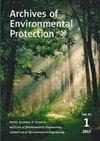Comparative analysis of selected water disinfection technologies with the use of life cycle assessment
IF 1.3
4区 环境科学与生态学
Q4 ENVIRONMENTAL SCIENCES
引用次数: 5
Abstract
: The objective of the paper is to use life cycle assessment to compare environmental impact of different technologies used in the process of water disinfection. Two scenarios are developed for water disinfection life cycle at ZUW Raba water treatment plant: (1) historical, in which gaseous chlorine is used as a disinfectant and (2) actual, in which UV radiation and electrolytically generated sodium hypochlorite are used for that purpose. Primary data is supplemented with ecoinvent 3 database records. Environmental impact is assessed by IMPACT2002+ method and its midpoint and endpoint indicators that are calculated with the use of SimaPro 8.4 software. The focus of the assessment is on selected life cycle phases: disinfection process itself and the water distribution process that follows. The assessment uses the data on fl ows and emissions streams as observed in the Raba plant. As the results of primal analysis show, a change of disinfectant results in quantitative changes in THMs and free chlorine in water supplied to the water supply network. The results of analysis con fi rm the higher potential of THMs formation and higher environmental impact of the combined method of UV/NaClO disinfection in distribution phase and in whole life cycle, mainly due to the increase of human toxicity factors. However, during the disinfection phase, gaseous chlorine use is more harmful for environment. But the fi nal conclusion states that water quality indicators are not signi fi cant用水消毒技术与生命周期评价的比较分析
本文的目的是利用生命周期评价来比较水消毒过程中不同技术对环境的影响。ZUW Raba水处理厂为水消毒生命周期制定了两种方案:(1)历史方案,使用气态氯作为消毒剂;(2)实际方案,使用紫外线辐射和电解生成的次氯酸钠作为消毒剂。原始数据补充了ecoinvent 3数据库记录。环境影响评估采用IMPACT2002+方法,使用SimaPro 8.4软件计算其中点和终点指标。评估的重点是选定的生命周期阶段:消毒过程本身和随后的配水过程。评估使用了在Raba工厂观察到的流量和排放流数据。初步分析结果表明,消毒剂的改变会导致供水管网供水中THMs和游离氯的数量变化。分析结果证实,UV/NaClO联合消毒方法在分布阶段和全生命周期内具有较高的THMs形成潜力和较高的环境影响,主要原因是人体毒性因素的增加。然而,在消毒阶段,气氯的使用对环境的危害更大。但最后的结论是水质指标不显著
本文章由计算机程序翻译,如有差异,请以英文原文为准。
求助全文
约1分钟内获得全文
求助全文
来源期刊

Archives of Environmental Protection
ENVIRONMENTAL SCIENCES-
CiteScore
2.70
自引率
26.70%
发文量
0
期刊介绍:
Archives of Environmental Protection is the oldest Polish scientific journal of international scope that publishes articles on engineering and environmental protection. The quarterly has been published by the Institute of Environmental Engineering, Polish Academy of Sciences since 1975. The journal has served as a forum for the exchange of views and ideas among scientists. It has become part of scientific life in Poland and abroad. The quarterly publishes the results of research and scientific inquiries by best specialists hereby becoming an important pillar of science. The journal facilitates better understanding of environmental risks to humans and ecosystems and it also shows the methods for their analysis as well as trends in the search of effective solutions to minimize these risks.
 求助内容:
求助内容: 应助结果提醒方式:
应助结果提醒方式:


